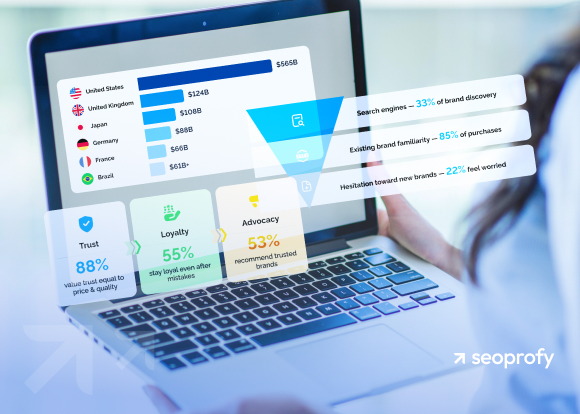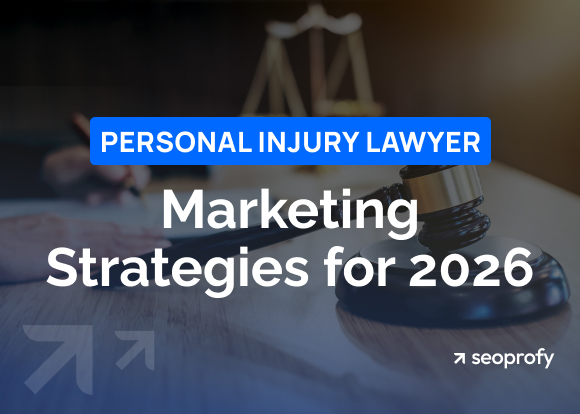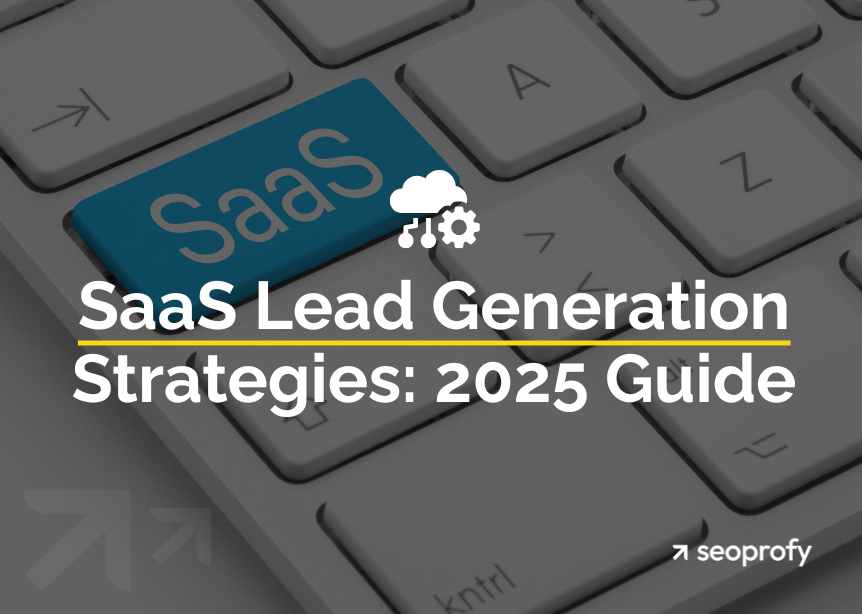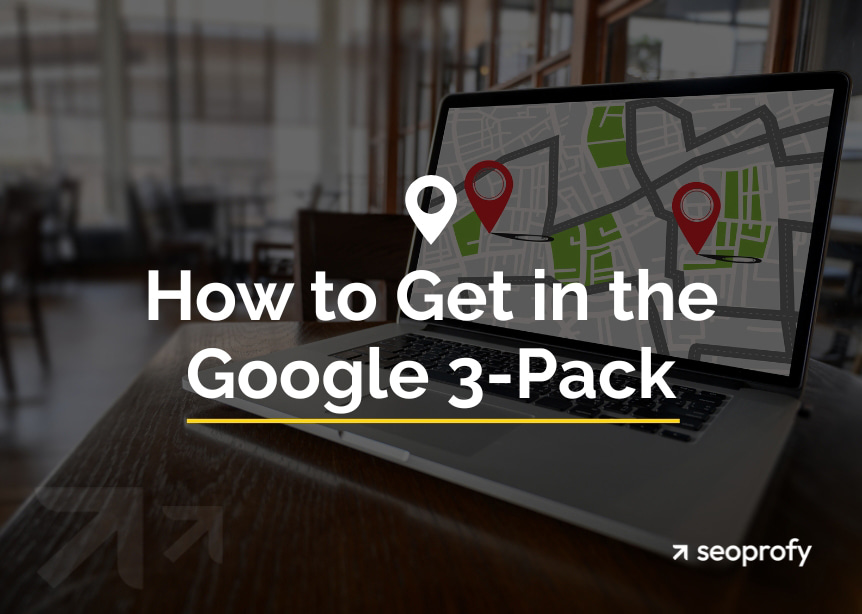Simply running an online shop with high-quality products isn’t enough to attract modern clients and encourage them to make a purchase. In case you want to grow a business that doesn’t just survive but flourish, you should go far beyond offering good customer service. That’s actually where you should opt for blogging for an ecommerce site to conquer your buyers’ hearts.
An online shop consists of different important elements such as landing and product pages. Nonetheless, you shouldn’t forget about the power of ecommerce blogging. It offers an efficient way to establish a connection with your customers, boost SEO, and drive more sales. Do you still wonder whether you should pay more attention to your online store blog? Continue reading to find out all the benefits you’ll get after improving your content!
- Product pages and categories should be optimized first. After that, you should pay attention to your blog.
- Focus on content types that directly support the customer journey, such as buying guides, comparisons, and how-to posts.
- Blogs can be effective when used strategically to boost authority and pass link equity.
The Role of Blogging in E-commerce
Running an ecommerce blog is not only about writing articles about your products. The creation of valuable, unique, and engaging content can guide your customers through their buying journey to making a desired purchase. Your blog is a powerful tool that can answer the buyers’ questions and show them how this or that product can solve their particular problems. Plus, the creation of high-quality content will have a positive impact on your brand recognition and chances of getting more sales.
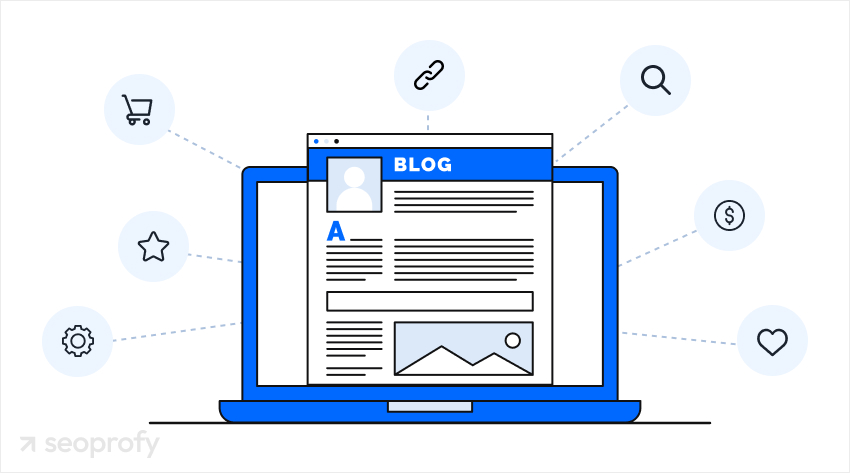
Why Most E-commerce SEO Guides Push Blogging
The role of an online store blog in business development is extremely important. Engaging content combined with the best SEO practices and proper ecommerce marketing strategy can provide you with jaw-dropping benefits, including:
- Increased organic traffic: You can add complex long-tail keywords to your high-quality blog posts, making them rank higher in Google search results and increasing the traffic flow to your store.
- Enhanced authority: The creation of articles with unique insights and useful tips will boost your expertise in the eyes of prospective clients.
- Higher engagement: The unique stories related to your products can increase engagement and establish connections with your buyers.
- More backlinks: The more valuable and interesting content you create, the higher the possibility that other websites in your niche will refer to it on their pages.
- Social media shares: Share your content on social media channels and via emails to inform your potential buyers of your new products, promotions, etc.
- Awareness-stage traffic attraction: Product comparisons and comprehensive reviews can easily attract users who want to discover more about a certain type of product.
- Internal links improvement: You can place links to relevant products in your articles to help the buyers move to the desired product page just right after reading a blog post.
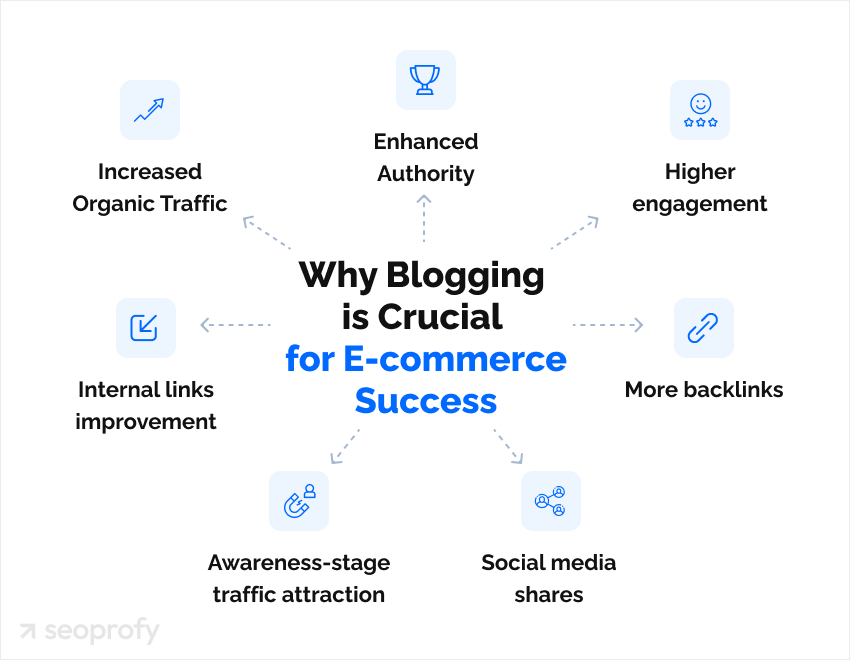
The Reality: Blogs vs. Product Pages for Driving Traffic
The interesting fact is that even small blogs can get nearly 44% of their website traffic from search engines. At the same time, it’s important to understand that an ecommerce blog isn’t a panacea for all your online business problems.
Real-life experience shows that articles contribute only a small fraction of conversions. As a rule, most of the site’s traffic and sales are generated by optimized product and category pages. Nonetheless, it’s still important to develop your blog if you want to ensure stable growth of your user engagement, brand awareness, topical authority, etc.
Case Studies: How Effective Is Blogging for E-commerce?
Recent SEO statistics prove that 61% of online shoppers in the US purchased their products due to the recommendations from blogs. Right now, we’ll review three real-life cases that highlight the importance of content marketing strategy in the overall development of your business. Plus, we’ll pay attention to the situations where blog posts may be less efficient than other types of pages.
Case Study 1: Blogs Drive Only 0.3% of Organic Traffic
As you can see on the screenshot, the blog drove only 0.3% of the organic traffic for Gorjana. In this particular case, the website’s homepage is the main source of clients. Nonetheless, this internet store still actively works on its blog to provide its buyers with useful tips related to jewelry care routine and the choice of the right gift size. It significantly increases the overall customer retention.
Case Study 2: A Guide Attracted 44 Organic Referring Domains
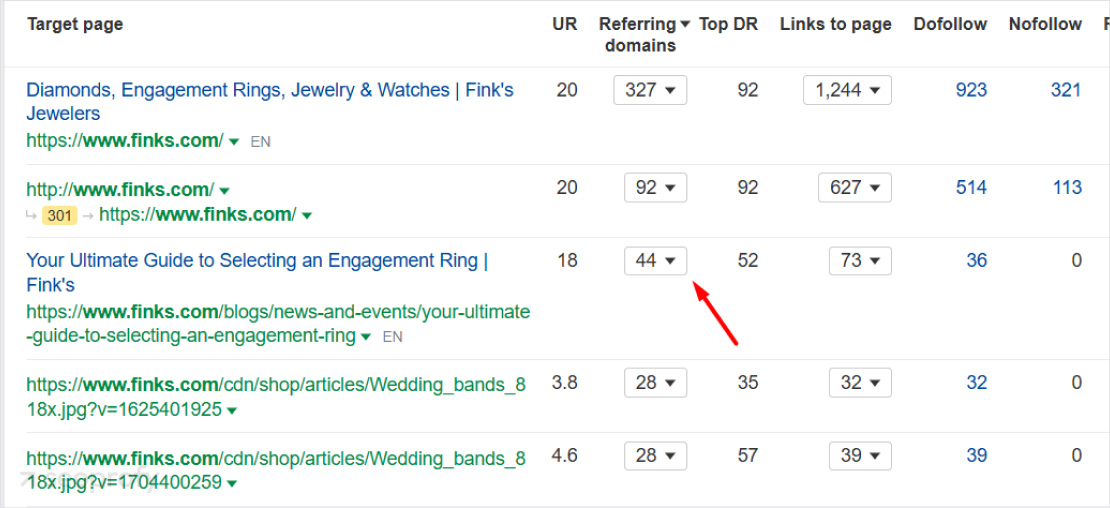
Getting backlinks is essential for the stable growth of your internet store rankings. You need to focus on the creation of unique and engaging content (such as tips, tops, and statistics) to inspire the owners of other websites to refer to your blog posts. As you can make sure, a comprehensive guide with useful tips can easily get 36 backlinks from other domains.
Case Study 3: How a Blog Post Boosted Product Page Rankings through Backlinks
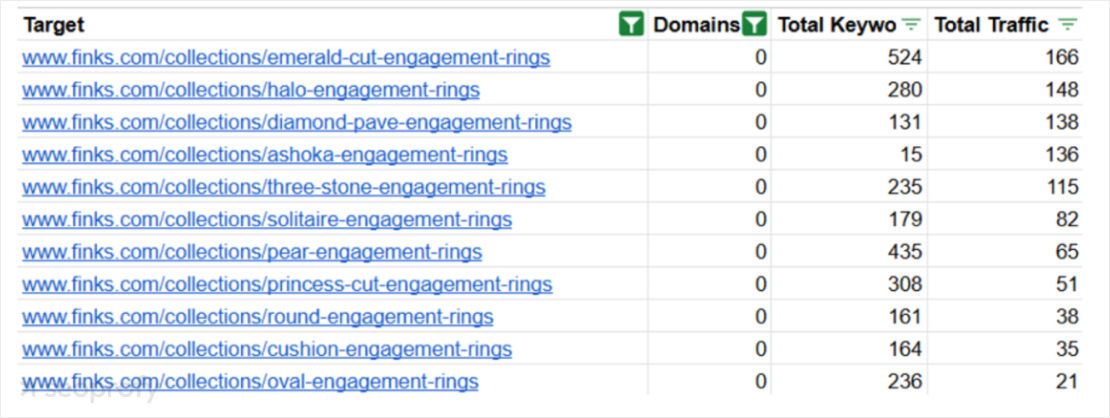
An attractive article can also play a pivotal role in enhancing the site’s authority by attracting organic backlinks. For instance, the post on Finks.com earned valuable external links from other websites. Now, these backlinks pass link equity (commonly referred to as ‘link juice’) to product and collection pages and improve their visibility in search engines. Additionally, this type of content can inspire users to explore more of what the website has to offer and increase overall engagement.
When Does Blogging Make Sense for E-commerce?
Of course, the main aim of any internet store is to attract as many buyers as possible to generate more revenue. That’s where an attractive ecommerce blog comes into play. With the proper content strategy and search engine optimization, it can become your powerful tool for attracting prospective buyers. Your posts can create more opportunities to convert these people into paying customers.
The Right Time to Focus on Blogging
Some owners of ecommerce websites may feel that running a blog is optional for the success of their business. While it’s true that your initial focus should be on optimizing key site elements like design, architecture, product pages, and the homepage, these foundational efforts are just the beginning.
Once your core pages achieve SEO success — such as high rankings for primary keywords and steady traffic — shifting your attention to creating engaging, high-quality content can take your business to the next level. A well-maintained blog will support additional conversions, foster better user engagement, and help your site achieve even higher rankings.
Shift Focus to Content Marketing
To shift your focus to content marketing, start by leveraging the main keywords you’ve already used for your product pages. Utilize these keywords as a foundation to develop a comprehensive content strategy that explores all topics relevant to your niche. Ensure your strategy addresses the main challenges and desires of your prospective buyers.
For example, if your product keywords include ‘sustainable fashion,’ create posts or guides that answer questions like ‘How to Build a Sustainable Wardrobe on a Budget’ or ‘Top 5 Benefits of Choosing Eco-Friendly Clothing.’ By targeting these pain points and interests, you can create compelling content that resonates with your audience and drives engagement.
Do you need a robust content strategy? SeoProfy is at your service! Rely on our team to unleash the true potential of your blog and reach the desired results:
- Higher search engine rankings
- Boosted conversions
- Enhanced online visibility and authority

High-Impact Blog Content Types for E-commerce
We’ve already mentioned in our SEO guide for ecommerce that running a blog is important for the successful search engine optimization of your internet store. Nonetheless, if you truly want to grab the attention of the target customers, you should know which articles to post to get the most out of them. Right now, we’ll briefly review the time-tested types of content for your ecommerce blog.
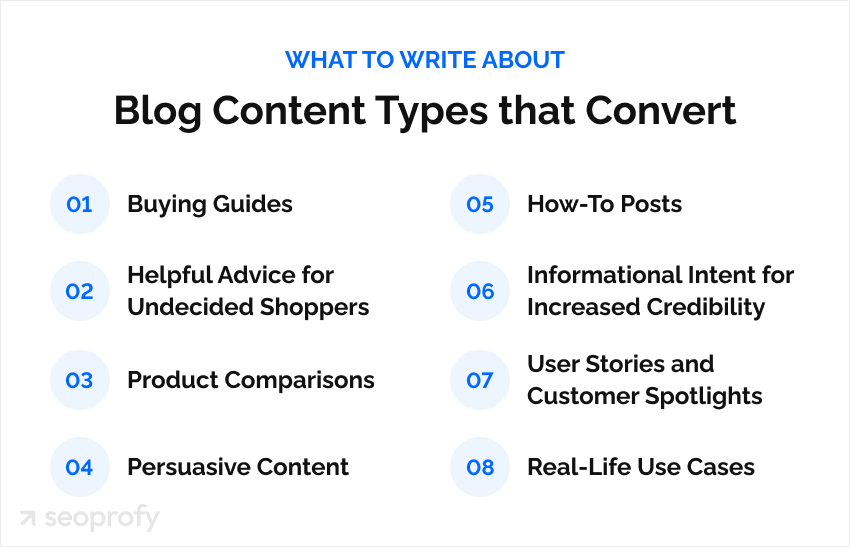
Buying Guides
Buying guides are an essential type of e-commerce marketing content designed to help users make informed decisions, while also curating recommendations from specific ecommerce brands to ensure customers find the best options available. These guides provide detailed insights into product features, comparisons, and use cases. They ensure that customers select items that meet their specific needs. For example, a buying guide for laptops might compare performance, battery life, and portability.
Helpful Advice for Undecided Shoppers
If you run an online business selling your own products, you can also focus on their unique features. Come up with a couple of exciting stories that will illustrate how your company’s solutions can help your prospective customers deal with their problems. Also, it’ll be great to prepare several blog posts in collaboration with the experts from your industry. Their approval of your products will surely persuade your customers to purchase the desired product.
Product Comparisons
It’s likely that your online store offers several items from one category but with different characteristics. It may be difficult for an average customer to choose the right option without a proper background or even knowledge of certain terms. Thus, you can simplify their decision-making process by providing articles comparing these products. Use understandable examples to highlight the main differences and similarities between the reviewed items.
Persuasive Content
Your posts should not only persuade a customer to buy a desired product but also to do it via your ecommerce business website. It’s extremely important to properly place CTAs in your articles. Their text should be short and encouraging enough to cause the desire to make a purchase right after reading a blog post.
How-To Posts
It doesn’t matter what items you sell, some of your customers surely need detailed instructions on how to use them. Of course, you can add the FAQ sections to your product pages but a blog will help you cover more questions. Use images, high-quality GIFs, and videos to provide step-by-step guidelines for your buyers. Plus, take into account that according to Backlinko, how-to-posts along with the list posts are the “most evergreen” content formats.
Informational Intent for Increased Credibility
The creation of engaging articles with useful information related to your products, industry, and customers’ pain points will help you grow your online authority. It’s extremely important for ecommerce sites not only to offer high-quality products but also to explain to the buyers how to overcome any possible issues related to their usage. Plus, you can review the industry news from time to time to prove to your clients you’re on top of the latest industry trends.
User Stories and Customer Spotlights
It’s not enough to simply praise your products’ benefits to persuade your customers of their reliability and high quality. Any successful e-commerce site should feature real-life buyers’ reviews. Thus, you should always motivate your clients to leave testimonials with photos and videos. Moreover, you can select some of the most prominent feedback and turn it into exciting stories for your blog.
Real-Life Use Cases
Finally, you can enhance your company blog with stories that illustrate the usefulness of the items you sell. For example, tell more about how these products simplified their inventors’ lives. Additionally, you may start reviewing some of your products in real-life conditions to test their durability, usefulness, and other important features.
How to Measure the Impact of Your E-commerce SEO Strategy
There is no reason to run an ecommerce blog without a proper analysis of its performance. Keeping an eye on your articles will help you understand which type of content is the most popular with your customers. Also, this is a sure way to define any gaps that prevent your site from reaching the top positions in search queries.
Apply an ROI-driven Approach to Content Marketing
Return on investment (ROI) helps you calculate the monetary value of an investment versus the resources you’ve spent on it. When it comes to e-commerce, you should ensure that all elements of your site, including its blog, help you reach your main aim – generate more income.
That’s where an ROI-driven content marketing strategy comes into play! It focuses on a smooth alignment of your article with the financial goals of your business. It means that your posts should be not only useful but also generate profit for your store. The best way to do it is to add the links to your products in the blog post.
Check how the audience interacts with them to find the most efficient places for your links. Thus, you’ll distribute the website traffic among the popular product pages, encouraging your users to make a purchase after reading an exciting story.
Use Google Search Console for Performance Insights
You may opt for Search Console Insights, which is a simplified version of Google’s Search Console available for all ecommerce sites. It uses the data from Google Analytics and Google Search Console to help you estimate your content. Using this powerful tool, you can discover:
- The most popular blog posts
- The performance of your new content
- The ways how people find your articles online
- The websites that refer to your content
Due to this essential information, you can better understand your audience and tailor your content to their interests. Also, it can provide you with valuable insights, such as new keywords, which you can use to improve your website’s SEO.
Analyze User Behavior in Google Analytics
Google Analytics is a powerful tool that allows you to measure the success of your online store blog and track how your customers interact with the website’s elements. Using this platform you can enter the Behavior category to analyze the following metrics:
- Behavior flow: It shows your users’ journey through your website. For example, you can see their interactions with various site elements and the sequence of the steps they take on your website. Using this data, you can define the perfect places for the CTAs and internal links for your customer’s smooth and clear navigation.
- Site search: This metric allows you to see what the buyers search for in your blog. Thus, you can understand what content you need to create, which existing articles are difficult to find, etc.
- Site content: Here, you should pay attention to the Landing Pages/Exit Pages. It will show you the posts where the customers land first on your site as well as the pages where they leave. Due to this metric, you can estimate whether your buyers’ journey happens as you’ve expected.
Track Keyword Rankings
Using Ahrefs and Semrush, you can conduct comprehensive keyword research. It’ll help you understand what words and phrases your prospective clients use while looking for the products you sell. As soon as you do it, you should naturally weave them into your blog posts to make them more relevant to your target audience’s pain points. Further, you stand a strong chance of increasing your website’s position in search queries.
Remember that every post is your opportunity to rank higher for specific keywords. It’s essential to keep an eye on this metric even after publishing an article as there may be a need to optimize it in case its position starts falling down.
Analyze Conversions and E-commerce Metrics
When running an ecommerce site, it’s essential to pay attention to the conversion rate, which shows how many of your online shop visitors have actually made a purchase. Of course, your blog posts can’t convert people into your customers, but still, they play a significant role in influencing their decision to buy your products. Plus, don’t forget to analyze the impact of your articles on other important e-commerce metrics:
- Average order value
- Customer retention
- Average basket size
- Abandoned cart rate
- Top-performing products
Use Google Analytics to Track Purchases and Sign-ups
You can track how your blog influences buyers with the help of Google Analytics. For example, when a person navigates from your article to the product page, you can check their next actions.
Following simple instructions provided by Google, you can easily set up conversion tracking for your website. After that, you’ll be able to see your buyers’ button clicks, site purchases, newsletter signups, etc. Try to find out whether there is a behavioral difference between the users who enter product pages directly from search queries and the ones who enter them from your posts.
Optimize Pages for Better Conversion Rates
Remember that SEO isn’t a sprint but a never-ending marathon. It’s not enough just to hire a freelance writer to create content for your blog regularly. Any user won’t spend even a minute on your e-commerce website if it doesn’t feature a clear architecture, attractive design, perfect mobile optimization, properly placed CTAs, and fast loading speed. Even the tiniest issues or poor product descriptions may have a disastrous effect on your conversion rates.
Thus, you should pay attention to your posts and other pages regularly to ensure they’re up to date. Further, they should be perfectly optimized for all modern devices, have a clear navigation system, etc.
Plus, you should always stay on top of the SEO trends. If you won’t be able to adapt to the changes, your business risks losing its rankings. Luckily, you can prevent such a situation with the help of a professional ecommerce SEO company like SeoProfy! Focus on your sales while our team will take care of your website, ensuring its constant growth.
Conversion Rate Optimization (CRO)
Keeping an eye on your CRO involves a variety of important actions:
- Analysis of the entire user journey
- A/B testing to refine headlines
- Experiments with CTAs, and page layouts.
Furthermore, it’s important to add social proof like other customer reviews and testimonials to build trust. Also, don’t forget to add FAQs with clear and brief answers to the most popular questions about your products.
Conclusion: Maximum Impact with Optimized Content Strategy
Blogging for ecommerce can undoubtedly boost your business, plunging your customers into an exciting world of stories that will reveal your products’ benefits. With the help of well-written and useful content, properly-placed CTAs, and visuals you can impact the buyers’ decisions persuading them to make a purchase without hesitation.
Follow the tips provided in our article to unleash your blog’s conversion opportunities. Publish thoughtful and valuable content related to your industry and products to convert your readers into leads. Invite them to find out more about this or that topic by submitting their emails or clicking CTAs. At the same time, ensure that all your call-to-action buttons naturally fit the topic of your e-commerce blog post.




